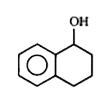Reaction A+2B+C→ Product, follows the rate law −d[C]dt=k[A]2 False statement regarding the above reaction is :
On doubling the concentration of B and C the rate of the reaction remains unaffected
Reducing the concentration of A to half, the rate becomes one-fourth
Half life period of the reaction depends upon the concentration of B
Half life period of the reaction is inversely proportional to the first power concentration of A
The correct Answer is:C
To solve the question regarding the reaction A+2B+C→Products and its rate law −d(C)dt=k(A)2, we need to analyze the implications of the given rate law and identify the false statement among the options provided.
1. Understanding the Rate Law:
The rate law given is −d(C)dt=k(A)2. This indicates that the rate of the reaction depends on the concentration of A raised to the power of 2, while the concentrations of B and C do not appear in the rate law. This suggests that A is the only reactant that affects the rate of the reaction.
Hint: Focus on how the rate law relates to the concentrations of reactants.
2. Analyzing the Half-Life:
For a reaction where the rate depends on (A)2, the half-life t1/2 can be derived from the integrated rate law. The half-life for a second-order reaction (in terms of A) is given by:
t1/2=1k(A)0
This shows that the half-life is inversely proportional to the initial concentration of A and does not depend on the concentration of B.
Hint: Recall the relationship between half-life and concentration for different orders of reactions.
3. Evaluating Statements:
- Statement A: "On doubling the concentration of B and C, the rate becomes one-fourth." This is false because the rate does not depend on B or C at all.
- Statement B: "The half-life period of the reaction depends on the concentration of B." This is false since the half-life only depends on (A).
- Statement C: "Reducing the concentration of A to half makes the rate one-fourth." This is true because if (A) is halved, (A)2 becomes one-fourth.
- Statement D: "The half-life period is inversely proportional to the first power of the concentration of A." This is true since the half-life is inversely proportional to (A)0.
4. Identifying the False Statement:
The false statement is Statement B, which claims that the half-life depends on the concentration of B. Since the rate law does not include B, this statement is incorrect.
Hint: Compare the implications of the rate law with each statement to identify inconsistencies.
Conclusion:
The false statement regarding the reaction is that the half-life period of the reaction depends on the concentration of B. The correct option is B.
The rate law given is −d(C)dt=k(A)2. This indicates that the rate of the reaction depends on the concentration of A raised to the power of 2, while the concentrations of B and C do not appear in the rate law. This suggests that A is the only reactant that affects the rate of the reaction.
For a reaction where the rate depends on (A)2, the half-life t1/2 can be derived from the integrated rate law. The half-life for a second-order reaction (in terms of A) is given by:
t1/2=1k(A)0
This shows that the half-life is inversely proportional to the initial concentration of A and does not depend on the concentration of B.
- Statement A: "On doubling the concentration of B and C, the rate becomes one-fourth." This is false because the rate does not depend on B or C at all.
- Statement B: "The half-life period of the reaction depends on the concentration of B." This is false since the half-life only depends on (A).
- Statement C: "Reducing the concentration of A to half makes the rate one-fourth." This is true because if (A) is halved, (A)2 becomes one-fourth.
- Statement D: "The half-life period is inversely proportional to the first power of the concentration of A." This is true since the half-life is inversely proportional to (A)0.
The false statement is Statement B, which claims that the half-life depends on the concentration of B. Since the rate law does not include B, this statement is incorrect.
The false statement regarding the reaction is that the half-life period of the reaction depends on the concentration of B. The correct option is B.
Similar Questions
Knowledge Check

Product (C) of the above reaction is :A B
B C
C D
D

Product (C) of the above reaction is :A1,3-hexadieneB1,4-pentadieneC1,3-butadieneD1,3-heptadiene
For a reaction A+B→ Products, the rate law is -Rate =k[A][B]3/2
Can the reaction be an elementray reaction ? Explain.
View SolutionReaction:A+2B→D follows the rate law: Rate =k[A][B]2/3 . The total order and unit of k will be :
View SolutionFor the reaction 2A+B→C with the rate low d[C]dt=k[A]1[B]−1 and started with A and B in stoichiometric proportion.Which is/are true ?
View SolutionFor a hypothetical reaction, A+B+C→ Products, the rate law is determined to be rate =k[A][B]2. If the concentration of B is doubled without changing the concentration of A and C, the reaction rate:
View SolutionFor a reaction, A+B→ Product, the rate law is given by r=k[A]12[B]2. What is the order of the reaction ?
View Solution
Give the products (B) and (C) in the above reaction.
View Solution

